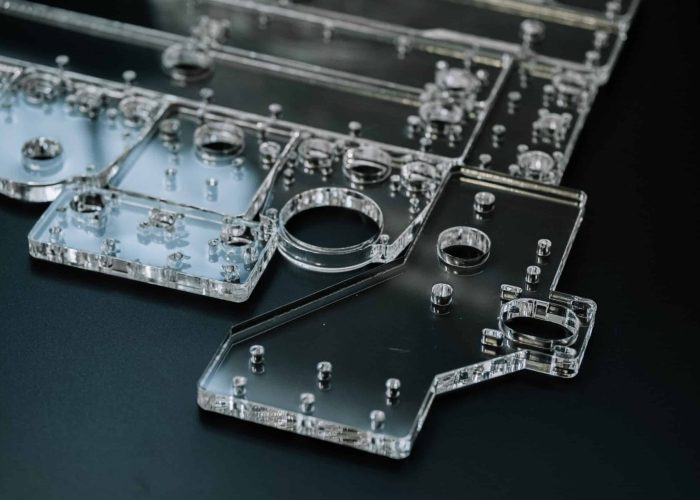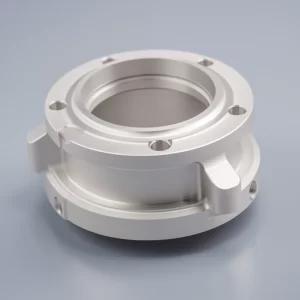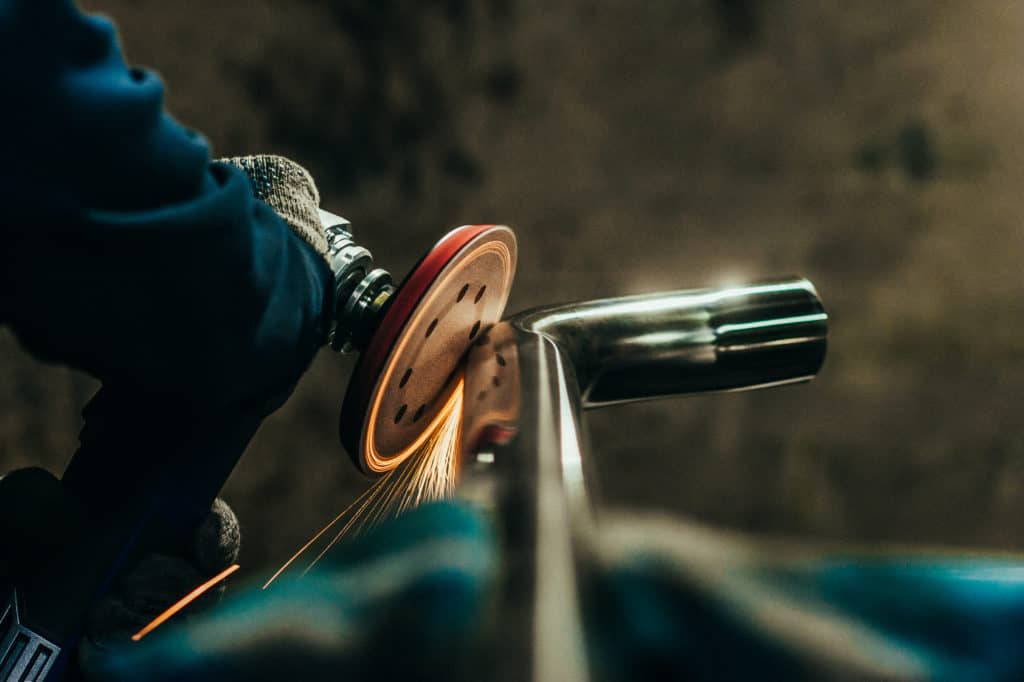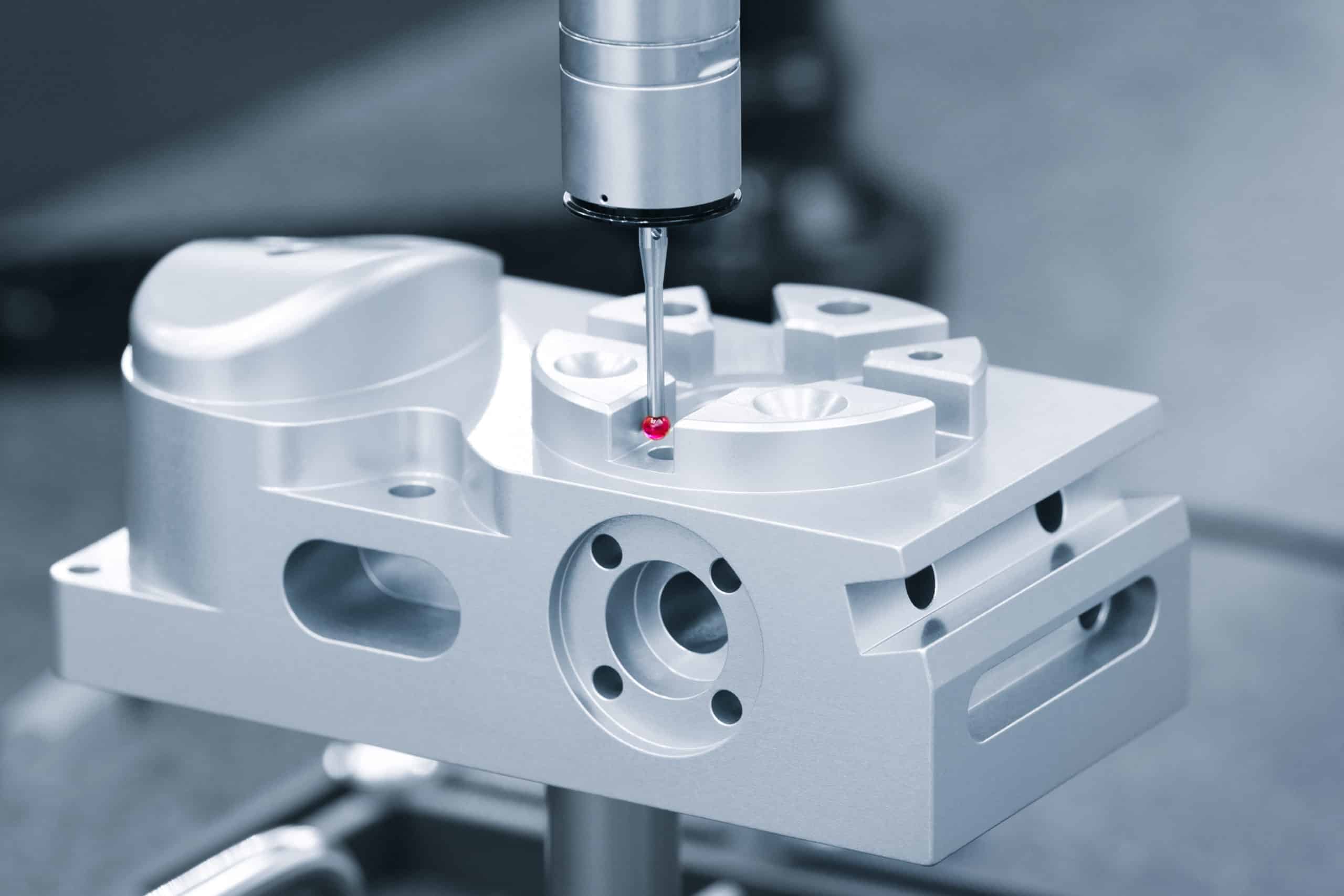Specifying the right tolerances for acrylic CNC parts can make or break your project’s success and budget. Too loose, and assemblies won’t fit properly or meet optical requirements. Too tight, and costs skyrocket unnecessarily. With decades of experience machining precision acrylic components for aerospace, audio, and medical applications, we see engineers struggle with these tolerance decisions daily—often over-specifying by 10x what’s actually needed.
CNC machining can achieve ±0.005″ to ±0.02″ (±0.13mm to ±0.5mm) tolerances on acrylic parts, with ±0.01″ being optimal for most precision assemblies. Standard general tolerance of ±0.005″ works for non-critical features, while optical components and tight-fit assemblies may require ±0.002″ or better with proper material selection and setup.
Discover how material choice impacts precision, when tight tolerances are worth it, and how to avoid costly over-engineering—featuring acrylic case studies.
Table of Contents
What Tolerance Can CNC Achieve on Acrylic Parts?
CNC machining typically achieves ±0.005″ (±0.13mm) standard tolerance on acrylic parts, with precision setups capable of ±0.002″ (±0.05mm) or tighter for critical features. Most non-critical dimensions work well at ±0.01″ (±0.25mm), while optical components and precision assemblies often require the ±0.002″ range.
- Standard tolerance: ±0.005″ (±0.13mm) for general features
- Precision tolerance: ±0.002″ (±0.05mm) for critical interfaces
- Tight tolerance: ±0.001″ (±0.025mm) achievable on reamed holes
We routinely verify ±0.002″ on acrylic parts using Mitutoyo CMM with 0.005mm accuracy. Sharp carbide tooling maintains ±0.001″ on specific features when material thermal expansion is controlled through proper feed rates and coolant management.
Most applications perform excellently within ±0.005″ tolerance bands. Audio faceplates need this precision for aesthetic alignment, while medical housings may require ±0.002″ for sealing interfaces. Optical components demanding ±0.001″ surface control represent specialized applications.
ISO 2768-m defines standard tolerances for unmarked dimensions. All precision features are verified using calibrated measurement equipment with documented inspection protocols.
Design Takeaway: Reserve ±0.002″ or tighter for functional features only. Apply ±0.005″ to ±0.01″ for general dimensions to optimize cost-effectiveness.
Cast vs Extruded: Which Acrylic Gives Better Tolerances?
Cast acrylic delivers superior tolerance capability, typically achieving ±0.002″ to ±0.005″ compared to extruded acrylic’s ±0.005″ to ±0.01″ range. Cast material’s uniform structure and lower internal stress make it more dimensionally stable during machining. For precision applications requiring tight tolerances, cast acrylic is the clear choice despite higher material cost.
- Cast acrylic: ±0.002″ to ±0.005″ tolerance capability, superior dimensional stability
- Extruded acrylic: ±0.005″ to ±0.01″ tolerance range, more economical material cost
- Precision applications: Cast material recommended for tolerances tighter than ±0.005″
We machine both materials daily across medical and audio projects, consistently seeing better dimensional consistency with cast acrylic. Extruded material tends to shift slightly during machining due to manufacturing stresses, while cast maintains shape stability even in thin sections requiring precise fits.
Cast acrylic works best for optical components, precision housings, and parts requiring tight assembly fits. Industry professionals recognize cast material’s superior machinability for demanding applications. Extruded material suits prototypes, signage, and general enclosures where standard tolerances meet requirements.
Material suppliers provide different thickness specifications for each type. Cast acrylic comes with tighter thickness control from manufacturing, while extruded offers more variation but better cost-effectiveness for less critical applications.
Design Takeaway: Choose cast acrylic when dimensional consistency and surface quality are priorities. Use extruded acrylic when material cost matters more than achieving the tightest possible tolerances.
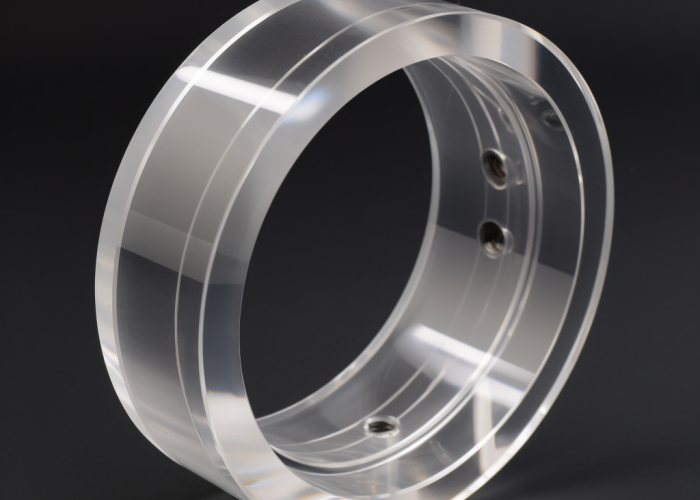
What Tolerance Do I Need for My Assembly Requirements?
Assembly fit requirements determine tolerance selection: ±0.002″ to ±0.005″ for tight fits, ±0.005″ to ±0.01″ for snug fits, and ±0.01″ to ±0.02″ for loose fits. The key is matching tolerance to functional need—tighter tolerances don’t automatically mean better performance. Over-specifying wastes budget without improving function.
- Loose fits: ±0.01″ to ±0.02″ for easy assembly with intentional gaps
- Snug fits: ±0.005″ to ±0.01″ for secure assembly with minimal play
- Tight fits: ±0.002″ to ±0.005″ for precise alignment or sealing
Medical device housings typically need ±0.002″ on sealing surfaces for proper gasket compression, while ±0.01″ works perfectly for mounting features. Audio equipment projects benefit from ±0.005″ on visible interfaces for gap-free appearance, but internal components function well at ±0.01″ based on successful assemblies.
Aerospace applications often require tighter control on critical interfaces, while consumer electronics work excellently with standard general tolerances. We’ve seen prototype projects waste budget specifying tight tolerances on non-functional features that perform identically with standard tolerances.
Different assembly types need different approaches based on real-world performance. Threaded features may require tighter control for proper engagement, while snap-fit components often work with standard tolerances. Parts that press together need careful tolerance control to avoid cracking during assembly.
Design Takeaway: Specify tight tolerances only on features affecting assembly fit. Use loose fits (±0.01″) for most applications, snug fits (±0.005″) for secure assembly, and tight fits (±0.002″) only when precise alignment or sealing is required.
How Do Tolerance Choices Affect Acrylic Machining Costs?
Tighter tolerances increase acrylic machining costs exponentially—moving from ±0.01″ to ±0.002″ typically adds 75-150% to part pricing. Standard ±0.005″ tolerance provides the best cost-performance balance. Each tolerance step tighter requires specialized equipment and extended machining time that drives up costs significantly.
- ±0.01″ tolerance: Baseline pricing with standard setup
- ±0.005″ tolerance: 15-25% price increase
- ±0.002″ tolerance: 75-150% price increase
We track cost data across thousands of acrylic parts, showing clear cost escalation as tolerances tighten. Parts requiring ±0.001″ tolerance often cost 200-300% more due to specialized fixturing and extended cycle times.
Precision work prevents efficient batch processing that reduces per-part costs. Setup time increases dramatically—standard parts might require 30 minutes setup, while tight tolerance work needs 2-3 hours for proper preparation.
Quality inspection costs multiply with tighter tolerances. Standard parts use quick gauges, while precision work demands detailed measurement taking much longer per part. Lead times also extend significantly for precision applications.
Design Takeaway: Budget 75-150% cost increase when specifying ±0.002″ tolerance over ±0.005″ standard. Consider if your application truly requires precision tolerance or if standard tolerance meets functional requirements at fraction of the cost.
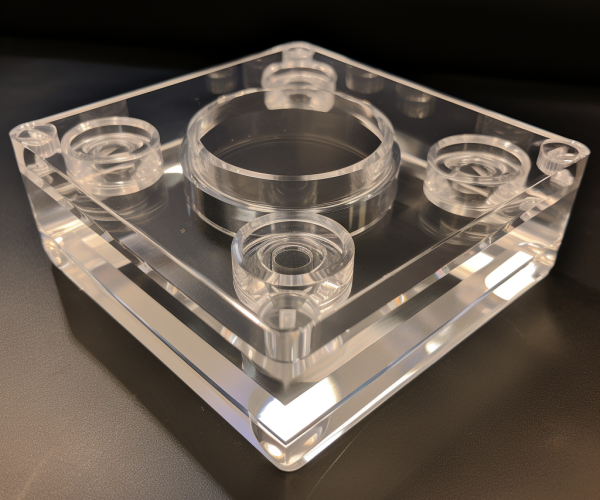
When Do Acrylic Parts Require the Tightest Tolerances?
Optical components, fluid control devices, and precision measurement tools represent applications genuinely requiring ±0.001″ to ±0.002″ acrylic tolerances. Most parts function perfectly with ±0.005″ standard tolerance. True precision applications involve light transmission or measurement accuracy where small variations impact performance.
- Optical windows: ±0.001″ surface control for clarity
- Flow channels: ±0.002″ for consistent flow rates
- Measurement tools: ±0.001″ for accuracy requirements
Laboratory equipment housing optical sensors demands tight tolerances because surface variations affect measurement accuracy. We machine windows for instruments where dimensional changes alter readings.
Custom manufacturing fixtures often need tight acrylic tolerances when positioning other components during assembly. High-end equipment manufacturers specify precision tolerances on bearing surfaces where looseness creates performance issues.
Most consumer products, prototypes, and general enclosures perform identically whether machined to ±0.002″ or ±0.01″ tolerance. Even applications that seem “precision” typically function perfectly with ±0.005″ standard tolerance.
Design Takeaway: Specify ±0.001″ to ±0.002″ tolerances only when dimensional variation measurably impacts optical performance or measurement accuracy. Standard tolerance satisfies 95% of real-world applications.
How Do I Specify Acrylic Tolerances Without Over-Engineering?
Start with general ±0.005″ tolerance, then identify specific features requiring tighter control through functional analysis. Most drawings benefit from applying ±0.002″ to only 10-20% of dimensions while using standard tolerance everywhere else. The key is systematic review of each feature’s actual function rather than applying tight tolerances uniformly.
- Step 1: Apply ±0.005″ general tolerance to entire drawing
- Step 2: Identify mating surfaces, sealing areas, and critical interfaces
- Step 3: Specify ±0.002″ only on features affecting assembly or performance
We conduct drawing reviews with customers weekly, finding most initial designs specify ±0.002″ on 80% of dimensions when only bearing surfaces and seal grooves actually require precision control. A systematic review process typically reduces precision callouts from 15-20 features down to 3-5 truly critical dimensions.
Use a feature-by-function approach during design reviews. Ask “what happens if this dimension varies by ±0.005″ versus ±0.002″?” for each callout. Mounting holes, chamfers, and general contours rarely affect assembly even with standard tolerance variation.
Mark up prints with colored pens during reviews—highlight features requiring precision in red, standard tolerance features in blue. This visual approach quickly identifies over-specified areas and helps focus tolerance control where it matters most.
Create tolerance review checklists covering sealing surfaces, bearing interfaces, threaded features, and optical surfaces. These typically represent the only features needing precision control in most acrylic applications.
Design Takeaway: Use systematic feature-by-function review to identify precision requirements. Start with general tolerance and upgrade specific features only when dimensional variation affects assembly, sealing, or performance—not appearance or convenience.
Conclusion
Acrylic tolerance selection balances precision with cost-effectiveness—±0.005″ standard tolerance satisfies most applications while ±0.002″ suits critical interfaces. Choose cast acrylic for dimensional consistency, specify tight tolerances only on functional features, and avoid over-engineering to control costs. Contact us to explore acrylic manufacturing solutions tailored to your product requirements.
Frequently Asked Questions
CNC machining typically achieves ±0.005″ (±0.13mm) standard tolerance on acrylic parts. Precision setups can hold ±0.002″ (±0.05mm) or tighter for critical features requiring optical clarity or tight assembly fits.
Cast acrylic delivers superior tolerance capability, achieving ±0.002″ to ±0.005″ compared to extruded acrylic’s ±0.005″ to ±0.01″ range. Cast material’s uniform structure provides better dimensional stability during machining.
Yes, moving from ±0.005″ to ±0.002″ tolerance typically increases costs by 75-150%. Precision work requires specialized equipment, slower machining speeds, and extended inspection time.
Optical components, precision measurement tools, and sealing interfaces typically need ±0.002″ or tighter. Most structural parts, prototypes, and general enclosures perform perfectly with ±0.005″ standard tolerance.
Start with ±0.005″ general tolerance, then specify ±0.002″ only on mating surfaces, sealing interfaces, and features affecting assembly fit. Most dimensions don’t require precision control.
Yes, use ±0.002″ tolerance on contact surfaces between acrylic and metal parts for proper fit. Standard ±0.005″ tolerance works for mounting holes and non-critical interfaces.
